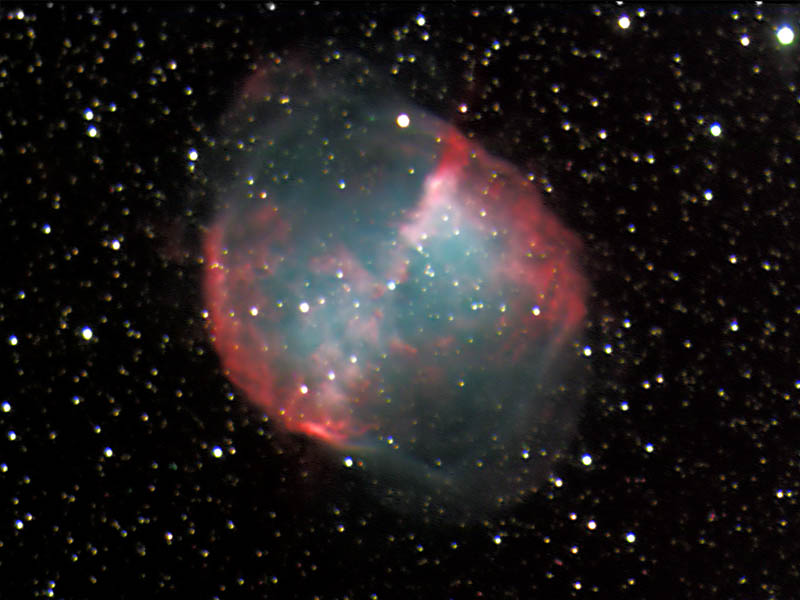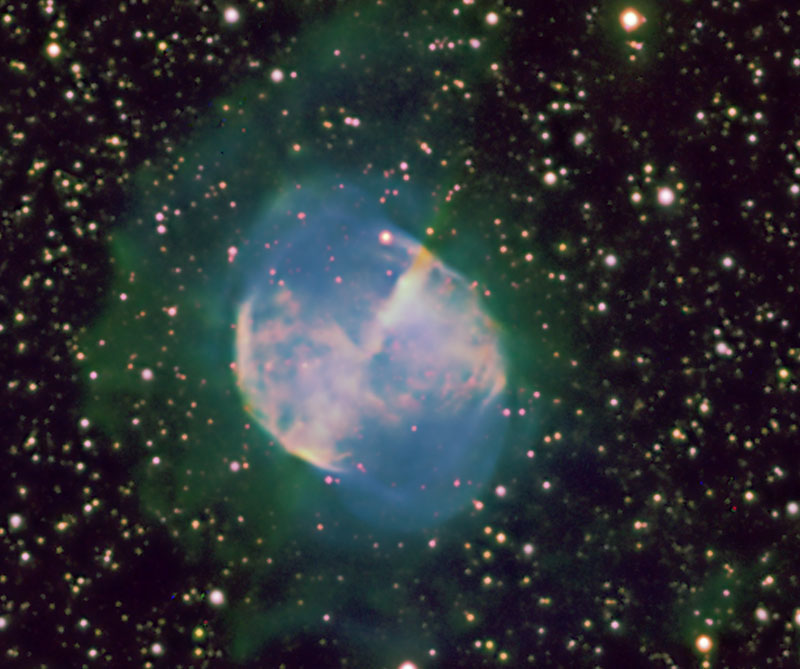
M27, known as the Dumbbell Nebula, is a planetary nebula in the constellation Vulpecula, about 1360 light years from Earth. These images are among the first I acquired while learning and experimenting with the telescope, camera, and color filters.
The goal for this image was to collect as much luminance as possible to reduce background noise. With nearly three hours exposure, the image looks better than earlier attempts. The following night I got an hour apiece for the color images unbinned, and that worked fairly well. (It would have been better to bin the color frames 2x2 for this LRGB image. Doing so would have collected more color data, providing a better signal-to-noise ratio.)

| Exposure |
|
||||||||
| Processing |
Master dark frame: 4.25 hours (51 x 5 min.), sigma-reject combined Dark and flat frame reduction in CCDSoft Luminance images combined in Ray Gralak's Sigma Clip pre-Beta 11 Color images average-combined CCDSoft Processing and LRGB-combined in Photoshop CS |
||||||||
| Date and Location |
October 15 & 16, 2004
Montpelier, Virginia, USA |
||||||||
| Equipment |
Celestron 9¼" at f/10 on a Celestron CGE equatorial mount SBIG ST-8XM camera SBIG AO-7 adaptive optics at about 4Hz. Optec IFW filter wheel with Astrodon TruBalance filters Optec TCF-S focuser Imaging and autoguiding with MaxIm DL 4.04 |
See M27 in natural-color light
This narrowband image reveals the extent of M27's ionized gas with 30-minute sub-exposures (now that our differential flexure problem is resolved). Notice how the nebulosity visible here covers a much larger area than in the natural-color image above, especially above and below the main nebula. For example, the green texture in the lower-right corner is a patch of ionized hydrogen gas, and another patch (mixed with ionized oxygen) is visible at the top-center.
This image assigns sulfur-II to the red channel, hydrogen-alpha to the green channel, and oxygen-III to the blue channel (this is the same palette used by the Hubble Space Telescope for its false-color images).

| Exposure |
|
||||||
| Processing |
Dark and flat-frame processing in CCDStack Channel sub-frames statistical-combined in CCDStack Levels, curves and color-combined in Photoshop CS3 |
||||||
| Date and Location |
October 29, 30 & 31 + November 3 & 4, 2007 Montpelier, Virginia, USA |
||||||
|
Equipment |
TMB-130SS APO refractor at f/7 on a Losmandy G-11 equatorial mount SBIG ST-8XM camera SBIG CFW-10 filter wheel with Astrodon filters Guide scope: 60mm f/5 refractor and ST-402 camera Imaging and autoguiding with MaxIm DL 4.57 |
Updated May 5, 2024